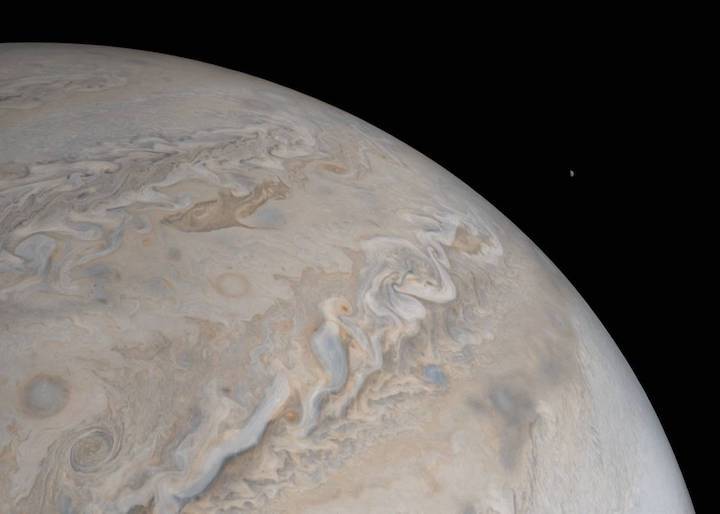27.07.2018
Dark ribbon around Jupiter reveals magnetic mystery
A painstaking search through historical photos has revealed an unexplained shadowy belt around Jupiter’s magnetic equator. Richard A. Lovett reports.
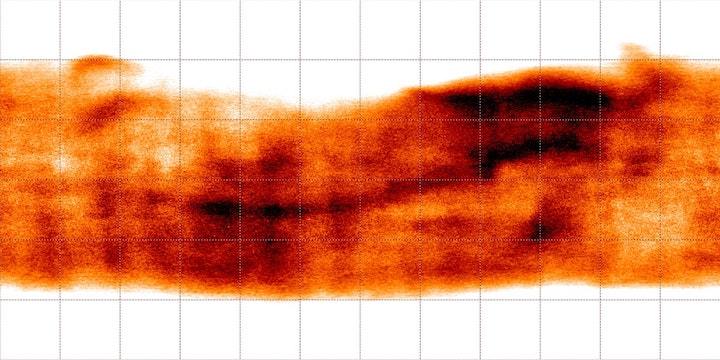
Planetary scientists studying images of Jupiter taken from some of the Earth’s largest telescopes have discovered a mysterious dark “ribbon” winding around the giant planet’s magnetic equator.
The equator is the region equidistant between a planet’s north and south poles. Unlike the geographic equator, the magnetic equator defined by the north and south magnetic poles, which on Jupiter, as on Earth, are tilted about 10 to 11 degrees from true north.
Not that this ribbon is visible to human eyes. In a paper published this week in Nature Astronomy, a team led by Tom Stallard, a planetary astronomer at the University of Leicester in the UK, found it by studying infrared emissions from H3+ ions, which are created by interactions between the planet’s magnetic field and an upper layer of its atmosphere known as the ionosphere.
“That molecule gets hot and starts glowing,” he says. “It’s a probe of the interaction between the atmosphere and the surrounding space environment.”
Most H3+ observations on Jupiter, he says, have focused on the magnetic poles, where the ions are associated with the planet’s aurorae.
Away from the poles, these emissions are much less intense. “It’s about 100 times weaker,” Stallard says. “The only way [to see it] is by using really big telescopes for a long time.”
That much observing time on such telescopes is hard to come by, so Stallard tried a different tack. Working with colleagues in the U.S. and Japan, he painstakingly stitched together 13,501 images taken in the late 1990s. These images were intended to support magnetic field studies by NASA’s Galileo spacecraft, which at the time was orbiting Jupiter. But their field of view was wide enough to encompass the rest of the planet. “I thought, ‘What if you take all that data and add it together?’” Stallard says.
It was a slow, painstaking process. But when it was done, he says, “We had the equivalent of several days of staring at every single part of the planet.”
The dark band at the equator was a surprise—suggesting that the interactions between Jupiter’s magnetic field and its ionosphere are much more complex than anticipated.
Of particular interest, Stallard says, is that the band is very narrow, with sharply defined edges. Most likely he says, the band marks places where Jupiter’s magnetic field is parallel to its surface, rather than plunging into it, as it does closer to the poles. But why the edges are so sharp is a mystery.
Such discoveries, Stallard says, are important not just to help us understand Jupiter. They also help us understand our own planet. “We think of Jupiter as alien,” he says, “but it’s more of a cousin.”
Studying its similarities and differences, he says, can help us learn more about our own world — something that’s particularly important when it comes to understanding the ionosphere. Radio communications regularly bounce signals off the Earth’s ionosphere. Satellites move within it and can be strongly affected by the way solar storms affect it. “I don’t think you can understand the Earth’s system until you have a broader understanding of other planets,” Stallard says.
Other scientists applaud the finding. “This is a very impressive scientific result,” says Randy Gladstone, a planetary scientist at the Southwest Research Institute, San Antonio, Texas.
In part it dovetails nicely with new observations being taken by NASA’s Jupiter-orbiting Juno spacecraft, for which Gladstone is the lead investigator for one instrument. But he is even more impressed by the methodology, which involved compiling all those thousand of images one by one. “That is an enormous amount of work to go to, when no useful outcome was guaranteed,” he says.
Quelle: COSMOS
---
Update: 27.08.2018
.
Time-lapse Sequence of Jupiter’s North
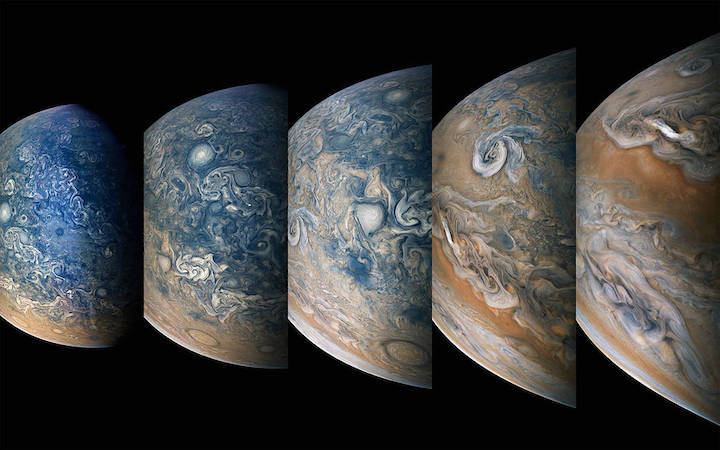
Striking atmospheric features in Jupiter’s northern hemisphere are captured in this series of color-enhanced images from NASA’s Juno spacecraft.
An anticyclonic white oval, called N5-AWO, can be seen at center left of the first image (at far left) and appears slightly higher in the second and third images. A tempest known as the Little Red Spot is visible near the bottom of the second and third images. The reddish-orange band that is prominently displayed in the fourth and fifth images is the North North Temperate Belt.
From left to right, this sequence of images was taken between 9:54 p.m. and 10:11 p.m. PDT on July 15 (12:54 a.m. and 1:11 a.m. EDT on July 16), as the spacecraft performed its 14th close flyby of Jupiter. At the time, Juno’s altitude ranged from about 15,700 to 3,900 miles (25,300 to 6,200 kilometers) from the planet's cloud tops, above a latitude of approximately 69 to 36 degrees.
Citizen scientists Gerald Eichstädt and Seán Doran created this image using data from the spacecraft’s JunoCam imager.
Quelle: NASA
---
Update: 28.08.2018
.
Jupiter Had Growth Disorders
Researchers of the Universities of Zurich and Bern and of ETH Zurich show how Jupiter was formed. Data collected from meteorites had indicated that the growth of the giant planet had been delayed for two million years. Now the researchers have found an explanation: Collisions with kilometer-sized blocks generated high energy, which meant that in this phase hardly any accretion of gas could take place and the planet could only grow slowly.
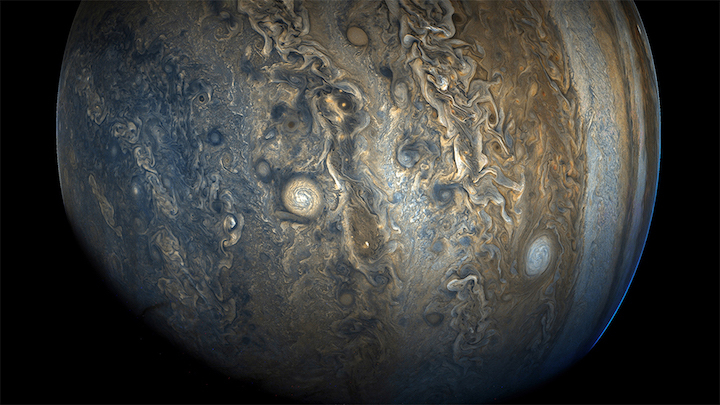
With an equator diameter of around 143,000 kilometers, Jupiter is the largest planet in the solar system and has 300 times the mass of the Earth. The formation mechanism of giant planets like Jupiter has been a hotly debated topic for several decades. Now, astrophysicists of the Swiss National Centre of Competence in Research (NCCR) PlanetS of the Universities of Zurich and Bern and ETH Zurich have joined forces to explain previous puzzles about how Jupiter was formed and new measurements. The research results were published in Nature Astronomy magazine.
Different phases of growth
“We could show that Jupiter grew in different, distinct phases,” explains Julia Venturini, postdoc at the University of Zurich. “Especially interesting is that it is not the same kind of bodies that bring mass and energy,” adds Yann Alibert, Science Officer of PlanetS and first author of the paper. First, the planetary embryo rapidly accreted small, centimeter-sized pebbles and quickly built a core during the initial one million years. The following two million years were dominated by slower accretion of larger, kilometer-sized rocks called planetesimals. They hit the growing planet with great energy, releasing heat. “During the first stage the pebbles brought the mass,” Yann Alibert explains: “In the second phase, the planetesimals also added a bit of mass, but what is more important, they brought energy.” After three million years, Jupiter had grown to a body of 50 Earth masses. Then, the third formation phase started dominated by gas runaway accretion leading to today’s gas giant with more than 300 Earth masses.
Solar system divided into two parts
The new model for Jupiter’s birth matches the meteorite data that were presented at a conference in the US last year. At first, Julia Venturini and Yann Alibert were puzzled when they listened to the results. Measurements of the composition of meteorites showed that in the primordial times of the solar system the solar nebula was divided into two regions during two million years. It could therefore be concluded that Jupiter acted as a kind of a barrier when it grew from 20 to 50 Earth masses. During this period, the forming planet must have perturbed the dust disk, creating an over-density that trapped the pebbles outside of its orbit. Therefore, material from outward regions could not mix with material of the inner ones until the planet reached enough mass to perturb and scatter rocks inwards.
Important interdisciplinary networking
“How could it have taken two million years for Jupiter to grow from 20 to 50 Earth masses?” asked Julia Venturini. “That seemed much too long,” she explains: “That was the triggering question that motivated our study.” A discussion by email started among NCCR PlanetS researchers of the Universities of Zurich and Bern and ETH Zurich and the following week the experts in the fields of astrophysics, cosmochemistry and hydrodynamics arranged a meeting in Bern. “In a couple of hours we knew what we had to calculate for our study,” says Yann Alibert: “This was only possible within the framework of the NCCR, which links scientists from various fields.”
Explanation for delayed growth
With their calculations, the researchers showed that the time the young planet spent in the mass range of 15 to 50 Earth masses was indeed much longer than previously thought. During this formation phase the collisions with the kilometer-sized rocks provided enough energy to heat the gaseous atmosphere of the young Jupiter and prevented rapid cooling, contraction and further gas accretion. “Pebbles are important in the first stages to build a core quickly, but the heat provided by planetesimals is crucial to delay gas accretion so that it matches the timescale given by the meteorite data,” the astrophysicists summarize. They are convinced that their results provide as well key elements for solving long-standing problems of the formation of Uranus and Neptune and exoplanets in this mass regime.
Quelle: University of Zurich
---
Update: 30.08.2018
.
How a NASA Scientist Looks in the Depths of the Great Red Spot to Find Water on Jupiter

For centuries, scientists have worked to understand the makeup of Jupiter. It’s no wonder: this mysterious planet is the biggest one in our solar system by far, and chemically, the closest relative to the Sun. Understanding Jupiter is key to learning more about how our solar system formed, and even about how other solar systems develop.
But one critical question has bedeviled astronomers for generations: Is there water deep in Jupiter's atmosphere, and if so, how much?
Gordon L. Bjoraker, an astrophysicist at NASA's Goddard Space Flight Center in Greenbelt, Maryland, reported in a recent paper in the Astronomical Journal that he and his team have brought the Jovian research community closer to the answer.
By looking from ground-based telescopes at wavelengths sensitive to thermal radiation leaking from the depths of Jupiter's persistent storm, the Great Red Spot, they detected the chemical signatures of water above the planet’s deepest clouds. The pressure of the water, the researchers concluded, combined with their measurements of another oxygen-bearing gas, carbon monoxide, imply that Jupiter has 2 to 9 times more oxygen than the Sun. This finding supports theoretical and computer-simulation models that have predicted abundant water (H2O) on Jupiter made of oxygen (O) tied up with molecular hydrogen (H2).
The revelation was stirring given that the team’s experiment could have easily failed. The Great Red Spot is full of dense clouds, which makes it hard for electromagnetic energy to escape and teach astronomers anything about the chemistry within.
“It turns out they're not so thick that they block our ability to see deeply,” said Bjoraker. “That’s been a pleasant surprise.”
New spectroscopic technology and sheer curiosity gave the team a boost in peering deep inside Jupiter, which has an atmosphere thousands of miles deep, Bjoraker said: “We thought, well, let’s just see what’s out there.”
The data Bjoraker and his team collected will supplement the information NASA’s Juno spacecraft is gathering as it circles the planet from north to south once every 53 days.
Among other things, Juno is looking for water with its own infrared spectrometer and with a microwave radiometer that can probe deeper than anyone has seen — to 100 bars, or 100 times the atmospheric pressure at Earth’s surface. (Altitude on Jupiter is measured in bars, which represent atmospheric pressure, since the planet does not have a surface, like Earth, from which to measure elevation.)
If Juno returns similar water findings, thereby backing Bjoraker’s ground-based technique, it could open a new window into solving the water problem, said Goddard’s Amy Simon, a planetary atmospheres expert.
“If it works, then maybe we can apply it elsewhere, like Saturn, Uranus or Neptune, where we don’t have a Juno,” she said.
Juno is the latest spacecraft tasked with finding water, likely in gas form, on this giant gaseous planet.
Water is a significant and abundant molecule in our solar system. It spawned life on Earth and now lubricates many of its most essential processes, including weather. It’s a critical factor in Jupiter’s turbulent weather, too, and in determining whether the planet has a core made of rock and ice.
Jupiter is thought to be the first planet to have formed by siphoning the elements left over from the formation of the Sun as our star coalesced from an amorphous nebula into the fiery ball of gases we see today. A widely accepted theory until several decades ago was that Jupiter was identical in composition to the Sun; a ball of hydrogen with a hint of helium — all gas, no core.
But evidence is mounting that Jupiter has a core, possibly 10 times Earth’s mass. Spacecraft that previously visited the planet found chemical evidence that it formed a core of rock and water ice before it mixed with gases from the solar nebula to make its atmosphere. The way Jupiter’s gravity tugs on Juno also supports this theory. There’s even lightning and thunder on the planet, phenomena fueled by moisture.
“The moons that orbit Jupiter are mostly water ice, so the whole neighborhood has plenty of water,” said Bjoraker. “Why wouldn't the planet — which is this huge gravity well, where everything falls into it — be water rich, too?”
The water question has stumped planetary scientists; virtually every time evidence of H2O materializes, something happens to put them off the scent. A favorite example among Jupiter experts is NASA’s Galileo spacecraft, which dropped a probe into the atmosphere in 1995 that wound up in an unusually dry region. "It's like sending a probe to Earth, landing in the Mojave Desert, and concluding the Earth is dry,” pointed out Bjoraker.
In their search for water, Bjoraker and his team used radiation data collected from the summit of Maunakea in Hawaii in 2017. They relied on the most sensitive infrared telescope on Earth at the W.M. Keck Observatory, and also on a new instrument that can detect a wider range of gases at the NASA Infrared Telescope Facility.
The idea was to analyze the light energy emitted through Jupiter’s clouds in order to identify the altitudes of its cloud layers. This would help the scientists determine temperature and other conditions that influence the types of gases that can survive in those regions.
Planetary atmosphere experts expect that there are three cloud layers on Jupiter: a lower layer made of water ice and liquid water, a middle one made of ammonia and sulfur, and an upper layer made of ammonia.
To confirm this through ground-based observations, Bjoraker’s team looked at wavelengths in the infrared range of light where most gases don’t absorb heat, allowing chemical signatures to leak out. Specifically, they analyzed the absorption patterns of a form of methane gas. Because Jupiter is too warm for methane to freeze, its abundance should not change from one place to another on the planet.
“If you see that the strength of methane lines vary from inside to outside of the Great Red Spot, it's not because there's more methane here than there,” said Bjoraker, “it's because there are thicker, deep clouds that are blocking the radiation in the Great Red Spot.”
Bjoraker’s team found evidence for the three cloud layers in the Great Red Spot, supporting earlier models. The deepest cloud layer is at 5 bars, the team concluded, right where the temperature reaches the freezing point for water, said Bjoraker, “so I say that we very likely found a water cloud.” The location of the water cloud, plus the amount of carbon monoxide that the researchers identified on Jupiter, confirms that Jupiter is rich in oxygen and, thus, water.
Bjoraker’s technique now needs to be tested on other parts of Jupiter to get a full picture of global water abundance, and his data squared with Juno’s findings.
“Jupiter’s water abundance will tell us a lot about how the giant planet formed, but only if we can figure out how much water there is in the entire planet,” said Steven M. Levin, a Juno project scientist at NASA’s Jet Propulsion Laboratory in Pasadena, California.
Quelle: NASA
---
Update: 17.09.2018
.
Juno Captures Elusive 'Brown Barge'
Quelle: NASA
---
Update: 11.10.2018
.
Jupiter in the Rearview Mirror
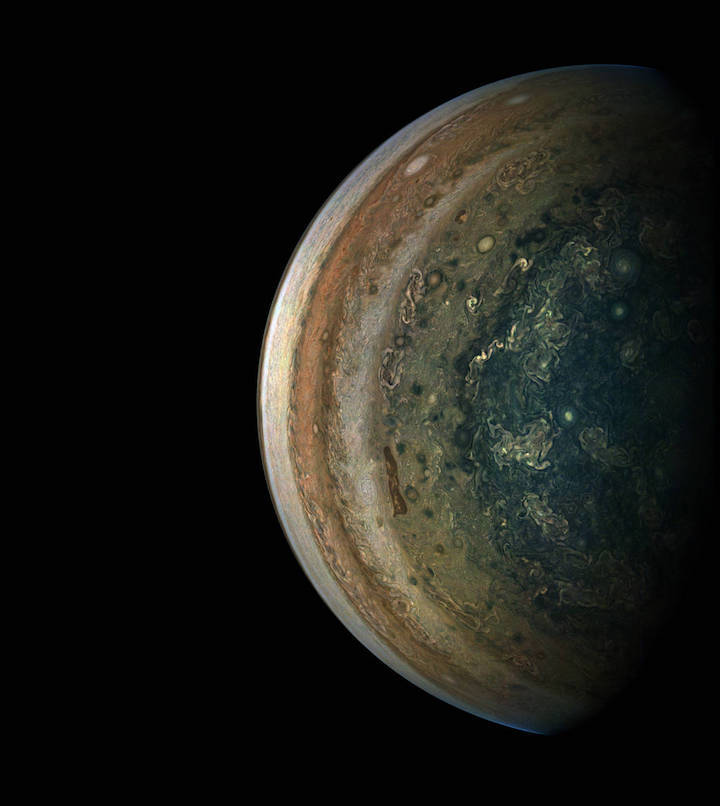
n the final minutes of a recent close flyby of Jupiter, NASA's Juno spacecraft captured a departing view of the planet's swirling southern hemisphere.
This color-enhanced image was taken at 7:13 p.m. PDT on Sept. 6, 2018 (10:13 p.m. EDT) as the spacecraft performed its 15th close flyby of Jupiter. At the time, Juno was about 55,600 miles (89,500 kilometers) from the planet's cloud tops, above a southern latitude of approximately 75 degrees.
Citizen scientist Gerald Eichstädt created this image using data from the spacecraft's JunoCam imager.
Quelle: NASA
---
Update: 24.10.2018
.
NASA's Juno Mission Detects Jupiter Wave Trains
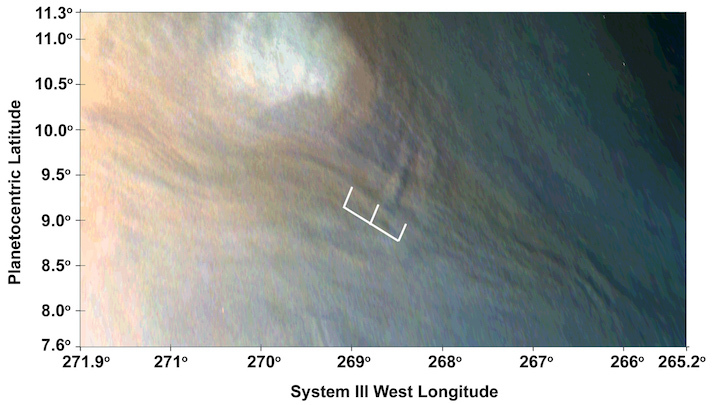
Three waves can be seen in this excerpt of a JunoCam image taken on Feb. 2, 2017, during Juno's fourth flyby of Jupiter. The region imaged in this picture is part of the visibly dark band just north of Jupiter's equator known as the North Equatorial Belt. Image credit: NASA/JPL-Caltech/SwRI/MSSS/JunoCam
Massive structures of moving air that appear like waves in Jupiter's atmosphere were first detected by NASA's Voyager missions during their flybys of the gas-giant world in 1979. The JunoCam camera aboard NASA's Juno mission to Jupiter has also imaged the atmosphere. JunoCam data has detected atmospheric wave trains, towering atmospheric structures that trail one after the other as they roam the planet, with most concentrated near Jupiter's equator.
The JunoCam imager has resolved smaller distances between individual wave crests in these trains than ever seen before. This research provides valuable information on both the dynamics of Jupiter's atmosphere and its structure in the regions underneath the waves.
"JunoCam has counted more distinct wave trains than any other spacecraft mission since Voyager," said Glenn Orton, a Juno scientist from NASA's Jet Propulsion Laboratory in Pasadena, California. "The trains, which consist of as few as two waves and as many as several dozen, can have a distance between crests as small as about 40 miles (65 kilometers) and as large as about 760 miles (1,200 kilometers). The shadow of the wave structure in one image allowed us to estimate the height of one wave to be about 6 miles (10 kilometers) high."
Most of the waves are seen in elongated wave trains, spread out in an east-west direction, with wave crests that are perpendicular to the orientation of the train. Other fronts in similar wave trains tilt significantly with respect to the orientation of the wave train, and still other wave trains follow slanted or meandering paths.
"The waves can appear close to other Jovian atmospheric features, near vortices or along flow lines, and others exhibit no relationship with anything nearby," said Orton. "Some wave trains appear as if they are converging, and others appear to be overlapping, possibly at two different atmospheric levels. In one case, wave fronts appear to be radiating outward from the center of a cyclone."
Although analysis is ongoing, most waves are expected to be atmospheric gravity waves - up-and-down ripples that form in the atmosphere above something that disturbs air flow, such as a thunderstorm updraft, disruptions of flow around other features, or from some other disturbance that JunoCam does not detect.
The JunoCam instrument is uniquely qualified to make such a discovery. JunoCam is a color, visible-light camera which offers a wide-angle field of view designed to capture remarkable pictures of Jupiter's poles and cloud tops. As Juno's eyes, it helps provide context for the spacecraft's other instruments. JunoCam was included on the spacecraft primarily for public engagement purposes, although its images also are helpful to the science team.
Juno launched on Aug. 5, 2011, from Cape Canaveral, Florida, and arrived in orbit around Jupiter on July 4, 2016. To date, it has completed 15 science passes over Jupiter. Juno's 16th science pass will be on Oct. 29. During these flybys, Juno is probing beneath the obscuring cloud cover of Jupiter and studying its auroras to learn more about the planet's origins, structure, atmosphere and magnetosphere.
JPL manages the Juno mission for the principal investigator, Scott Bolton, of Southwest Research Institute in San Antonio. The Juno mission is part of the New Frontiers Program managed by NASA's Marshall Space Flight Center in Huntsville, Alabama, for the Science Mission Directorate. Lockheed Martin Space Systems in Denver, Colorado, built the spacecraft. JPL is a division of Caltech in Pasadena, California.
Quelle: NASA
---
Update: 10.11.2018
.
Jovian Close Encounter
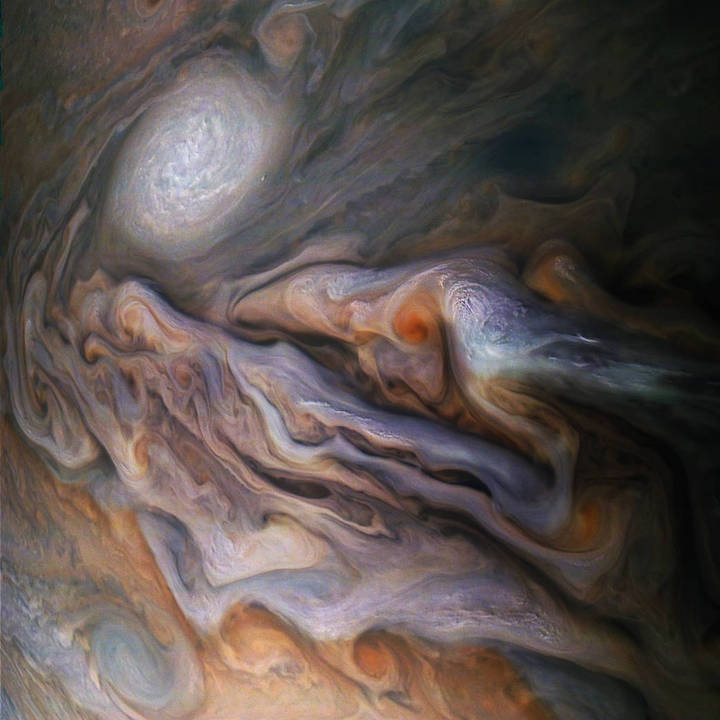
A multitude of magnificent, swirling clouds in Jupiter's dynamic North North Temperate Belt is captured in this image from NASA's Juno spacecraft. Appearing in the scene are several bright-white “pop-up” clouds as well as an anticyclonic storm, known as a white oval.
This color-enhanced image was taken at 1:58 p.m. PDT on Oct. 29, 2018 (4:58 p.m. EDT) as the spacecraft performed its 16th close flyby of Jupiter. At the time, Juno was about 4,400 miles (7,000 kilometers) from the planet's cloud tops, at a latitude of approximately 40 degrees north.
Citizen scientists Gerald Eichstädt and Seán Doran created this image using data from the spacecraft's JunoCam imager.
Quelle: NASA
---
Update: 18.11.2018
.


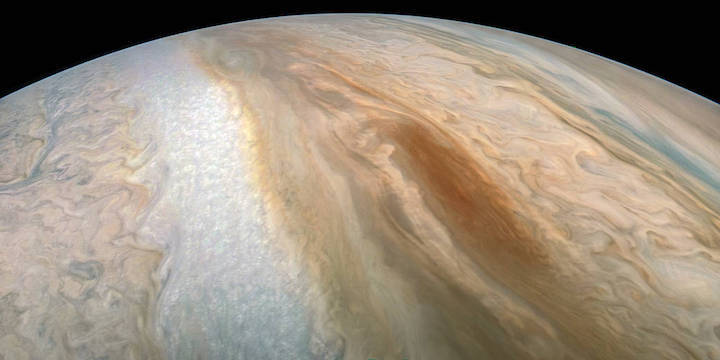 A long, brown oval known as a "brown barge" in Jupiter's South Equatorial Belt is captured in this color-enhanced image from NASA's Juno spacecraft.
A long, brown oval known as a "brown barge" in Jupiter's South Equatorial Belt is captured in this color-enhanced image from NASA's Juno spacecraft.